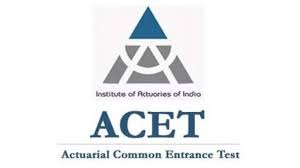ACET-2020
|
Section |
MARKS |
|
Mathematics |
30 |
|
Statistics |
30 |
|
Data Interpretation |
15 |
|
English |
15 |
|
Logical Reasoning |
10 |
|
TOTAL |
100 |
- Number of Question: Total 70 Questions will be asked in the exam.
- Exam Mode: Exam will be conducted through online mode.
- Negative Marking: There shall be NO negative marking for wrong answers.
- Exam Duration: The exam duration will be 3 Hours.
- Type of Question: There will be objective type questions (four options with one correct answer).
The total distribution of questions would be:
1. 45 questions – 1 mark each
2. 20 questions – 2 marks each
3. 05 questions – 3 marks each
Syllabus for ACET Examination will include the following:
1) Mathematics
2) Statistics
3) English
4) Data Interpretation
5) Logic
1) Mathematics-
a) Notation and standard functions
b) Numerical Methods
c) Algebra
d) Differentiation
e) Integration
f) Vectors
g) Matrices
2) Statistics
a) Permutations and combinations
b) Types of data
Statistical diagrams, bar chart, histogram, dot plot, stem-and-leaf, boxplot
c) Measures of location mean, median, mode
d) Measures of spread range, interquartile range, standard deviation, variance, Skewness
e) Probabilities basic rules of probabilities
f) Advanced probabilities tree diagrams, conditional probabilities
g) Discrete random variables definitions, probabilities, mean, mode, median, standard deviation, variance, coefficient of skewness
h) Continuous random variables definitions, probabilities, mean, mode, median, standard deviation, variance, coefficient of skewness
i) Discrete distributions uniform, Bernoulli, binomial, Poisson
j) Continuous distributions continuous uniform, exponential, the normal distribution
k) Correlation scatter plots, covariance, correlation coefficient
l) Regression
3) English
a) Vocabulary Based (Synonyms Antonyms)
b) English Usage or Grammar
c) Sentence Correction
d) Fill in the blanks
e) Cloze Passage
f) Analogies or Reverse Analogies
g) Jumbled Paragraph
h) Meaning-Usage Match
i) Summary Questions
j) Verbal Reasoning
k) Facts / Inferences / Judgements
l) Reading Comprehension
Vocabulary: Vocabulary questions test the candidate’s knowledge of the primary meanings of words, secondary shades of meaning, usage, idioms and phrases, antonyms, related words, etc.
Grammar: Grammar-based questions test the candidate’s ability to spot and correct grammatical errors. It should generally tests knowledge of high school level grammar and includes areas like subject-verb agreement, use of modifiers, parellel construction, redundancy, phrasal verbs, use of articles, prepositions, etc.
Verbal Reasoning: Verbal reasoning questions are designed to test the candidate’s ability to identify relationships or patterns within groups of words or sentences.
4) Data Interpretation
Data is given in form of tables, charts and graphs. In this section it is tested that how can you interpret the given data and answers the questions based on it.
a) Tables
b) Column Graphs
c) Bar Graphs
d) Line Charts
e) Pie Chart
f) Venn Diagrams
g) Caselets
Combination of two or more types linked to each other.
5) Logical Reasoning
a) Number and Letter Series
b) Calendars
c) Clocks
d) Cubes
e) Venn Diagrams
f) Binary Logic
g) Seating Arrangement
h) Logical Sequence
i) Logical Matching
j) Logical Connectives
k) Syllogism
l) Blood Relations
Disclaimer: The information provided here is best to our knowledge. It is highly recommended that you should cross-check the source of information through the specific Colleges and Institutes. Career Prabhu Education Pvt Ltd. is in no way responsible for the decisions made solely on the basis of this document.



